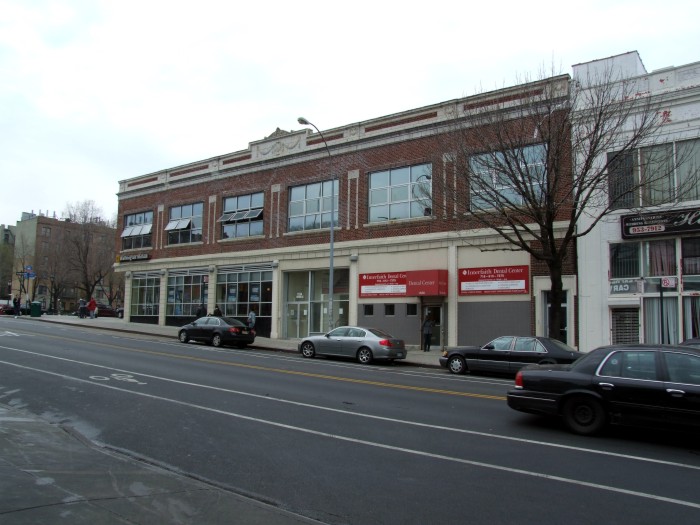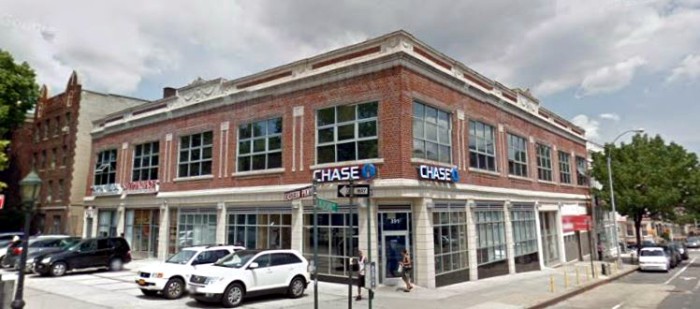Building of the Day: 1534 Bedford Avenue
Brooklyn, one building at a time. Name: Originally Mulford-Haas Motor Company, now Chase Bank Address: 1534 Bedford Avenue Cross Streets: Corner Eastern Parkway Neighborhood: Crown Heights North Year Built: 1916-1917 Architectural Style: Colonial Revival Architect: Albert Kahn & Ernest Wilby Other works by architect: Kahn-Numerous factories for Ford, Chrysler, GM, Packard Motors. Naval bases, many…


Brooklyn, one building at a time.
Name: Originally Mulford-Haas Motor Company, now Chase Bank
Address: 1534 Bedford Avenue
Cross Streets: Corner Eastern Parkway
Neighborhood: Crown Heights North
Year Built: 1916-1917
Architectural Style: Colonial Revival
Architect: Albert Kahn & Ernest Wilby
Other works by architect: Kahn-Numerous factories for Ford, Chrysler, GM, Packard Motors. Naval bases, many buildings on University of Michigan campus, among others. With Wilby-Ford Highland Park plant, U of Mich. Buildings.
Landmarked: No
The story: Albert Kahn was one of the greatest American architects of the 20th century. Specializing in factories, those unglamorous buildings usually assigned to a junior member of a design firm, Kahn, along with his associate, Ernest Wilby, and later his brother, Julius, was responsible for some of the automobile industry’s most iconic buildings, and helped make industrial design and engineering a respected part of the architectural pantheon.
Kahn was born in Prussia, in 1869, the son of a rabbi. His father came to America in 1879, and he and his mother, along with some of his siblings, joined him in Baltimore, before the family moved to Detroit. As the oldest son, Albert was soon working to support the family, and one of his jobs was office boy in the architectural firm of Mason and Rice. His love of architecture grew there, and his talent for drawing was recognized by George Mason, who soon promoted him from office boy to draftsman. He would work for Mason and Rice for over ten years, learning the trade. He also won a scholarship to study abroad for a year, and he wandered around Italy, France, Belgium and Germany with another young architect, Henry Bacon, Jr., who would one day design the Lincoln Memorial.
When he came back from Europe, Mason promoted him to head designer, but he soon decided to go out on his own, with two of his colleagues. He still worked with Mason on a project called the Palms Apartments, Kahn’s introduction to working in reinforced concrete. It was a revelation, and this building material and the engineering of it in factory buildings would make his career. He then partnered with Ernest Wilby, and their association would last from 1903 until 1918.
By 1903, younger brother Julius was an engineer, and with his brother, had devised new and innovative ways of designing factory buildings with reinforced steel. They got to try it out in 1905, in the tenth building Kahn designed for the Packer Motor Company in Detroit. The first nine buildings were the usual brick and wood beamed factory buildings, but number 10 was different. Julius Kahn’s engineering had devised ways to carry the load through the steel in reinforced concrete, enabling Albert to design a modern factory without a lot of space impeding wooden support beams, a factory that was light and airy, due to the large windows that could now be built. The concrete absorbed the vibrations of the plant, and was fireproof, to boot. Building 10 was beautiful, so much so that tourists came out to see it. One of them was Henry Ford.
He commissioned Kahn to build a factory for his Model T’s, and a 34 year partnership followed, with Ford’s “Chrystal Palace,” the plant in Highland Park, the most famous of the Kahn Ford plants. Other commissions for General Motors and Chrysler followed, as well as buildings for the University of Michigan, and countless more homes, synagogues, office buildings, factories, military facilities and other buildings would follow in his long and impressive career. Kahn died in Detroit in 1942.
During the period Kahn was designing for Ford, he not only built the big plants, he designed the smaller showrooms in cities around the country. Here in Brooklyn, on Bedford Avenue, on “Automobile Row,” as the street was called, he and Wilby designed this showroom, finished in 1917. Ford leased it to the Mulford-Haas Company, later called Haas Motor Car Co., which sold and serviced Ford automobiles.
Brooklyn was car crazy back then, as now, as assembly line construction, pioneered by Ford, made automobiles affordable to working people, and Bedford Avenue, as one of Brooklyn’s major north/south thoroughfares, was the perfect place for showrooms, dealerships, garages and auto body shops to congregate. For more on Automobile Row, see this recent Walkabout piece, Part One and Two.
Kahn was not only a master of factory design, he was also well versed in the architectural styles of the day, and had designed many great homes and other buildings in a multitude of popular styles. Colonial Revival was especially popular then, and this showroom combines the utilitarian need for open spaces and large windows for display, as well as office and service areas, and some major curb appeal, in the familiar Colonial Revival style. Reinforced concrete, visible on the façade, with brick sheathing makes for a handsome showroom.
Haas Motor Car Company sold and serviced Fords and Lincolns until they closed in 1935. Other car companies, and then miscellaneous businesses took over the space. In the 1980s, the tax photos show it being a subdivided into a pharmacy and two other businesses. In 1993, it was a clinic, part of Interfaith Hospital, which still has offices upstairs, and the ground floor has been a bank branch since 2009, first a Washington Mutual, and now Chase Bank, along with two other small business offices. GMAP






What's Your Take? Leave a Comment